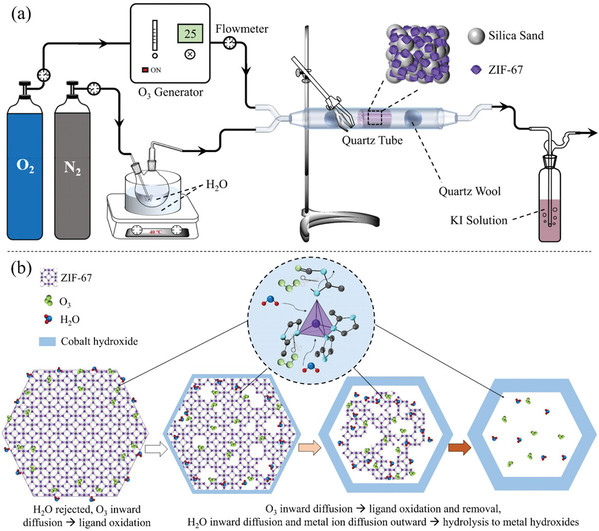Unusual Post Modulation of Pore Size, Nanostructure, and Composition of Metal-Organic Frameworks via Cooperative Ozone/Water Co-Etching
Mao Dongling, Huang Guoqing, Wu Lei, Hu Zeyu, Lou Yao-Yin, Wu Winston Duo, Wu Zhangxiong*(吴张雄)
Particle Engineering Laboratory School of Chemical and Environmental Engineering, and Suzhou Key Laboratory of Novel Semiconductor-optoelectronics Materials and Devices, College of Chemistry Chemical Engineering and Materials Science, Soochow University Suzhou, Jiangsu 215123, P. R. China
Adv. Funct. Mater., 2023, 230395
Abstract:Rational engineering of pore structure and size, nanostructure, and local composition of metal-organic frameworks (MOFs) plays a crucial role for their applications. Herein, a facile O3/H2O co-etching strategy is reported to treat ZIF-67 to synthesize derivatives with novel and hard-to-acquire structures and properties, including mesoporous ZIF-67 dodecahedra with variable mesopore sizes (3-30 nm), core-shell and core-void-shell mesoporous ZIF-67@amorphous cobalt hydroxide dodecahedra, and hollow dodecahedral frameworks. In the cooperative etching mechanism, O3 diffuses into the hydrophobic ZIF-67 to progressively oxidize the ligand to create functional groups, mesopores and voids, while the enhanced hydrophilicity and pore size allow H2O to diffuse inside to hydrolyze the metal centers to form cobalt hydroxide shells. The co-etching boosts the performance of ZIF-67 in the electrocatalytic oxygen evolution reaction. The derived core-void-shell material possesses a highly attractive performance (an overpotential of 286 mV, a Tafel slope of 59.5 mV dec-1, and a stability of >20 h) because of the presence of amorphous cobalt species, large pores, hierarchal structure, and high hydrophilicity. This work provides a general approach for post engineering of MOFs to create novel structures and functionalities.

链接://onlinelibrary.wiley.com/doi/10.1002/adfm.202303958